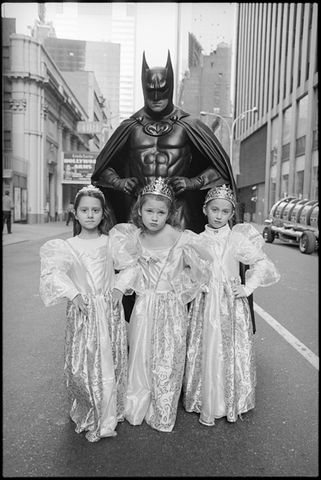Exhibition
New York - States of Mind
Exhibition and films show New York experienced as a political space
Fri, Aug 24–Sun, Nov 4, 2007

Through the works of pioneers such as Marcel Duchamp, Hans Haacke, Gordon Matta-Clark, as well as of Kehinde Wiley, Carolee Schneemann, Jon Kessler and other artists, the exhibition "New York - States of Mind" presents a defining aspect of the New York art scene. With drawings, paintings, sculptures, photographs, films, video installations and mixed media works by 26 artists and two artist collectives living and working in New York, the exhibition and the film programme comprising "New York - States of Mind" show various ways in which artists approach the city as an experiential and inherently political space.
Curated by Shaheen Merali in collaboration with Queens Museum of Art, NY
An exhibition with works by
Iona Rozeal Brown, Ian Burns, Laura Carton, Carolina Caycedo, CUP, Marcel Duchamp, Rainer Ganahl, Hans Haacke, David Hammons, Jonathan Horowitz, Tehching Hsieh, Kim Jones, Jon Kessler, Mark Lombardi, Mary Ellen Mark, Sarah Morris, Gordon Matta-Clark, Josephine Meckseper, Ana Mendieta, William Pope.L, Printed Matter, Inc., Elaine Reichek, Carolee Schneemann, Ward Shelley, Tavares Strachan, Kehinde Wiley, Fred Wilson and Jordan Wolfson.
The exhibition consists of five sections. You can find more information and an interview with one artist of each section here:
5. Shangri-La
The exhibition places the art and the urban space of New York in a contemporary (art-) historical context. "'States of mind' stands for the creativity with which the artists of the exhibited works handle their complex materials in representing the diversity of New York," says curator Shaheen Merali, who was responsible for the selection of the artists. "Our curatorial interest is focused on a special way of reading the city as an urban space in which various cultural, sexual, social and political perceptions meet."
The works of the selected artists counter the stereotypical images of the city with alternative perceptions of urban life. In one legendary performance, Tehching Hsieh voluntarily lives as a homeless person for a full year. Artists such as Gordon Matta-Clark, Sarah Morris and Mary Ellen Mark find their material in the skyscrapers, industrial ruins and carnival parades of the city itself.
"New York - States of Mind" understands the street as a metaphor for New York. The streets are where the city's various ethnic and social groups come into contact, giving rise to a public realm not structured by the media, but constantly creating itself anew. The artistic gaze transforms the supposedly transparent street grid of New York City into a labyrinth of spaces and historical relationships. In the same way that Gordon Matta Clark's violent interventions in the city's urban space in the 1970s exposed hidden structures, the works on exhibit reveal different perceptions of urbanity, diversity, desire and art history.
Works of the dadaist Marcel Duchamp form the art-historical starting point of the exhibition, establishing the relationship between Europe and the USA. Duchamp lifted utilitarian objects from their original context and, through the act of signing them, set them in the artistic realm; with these "ready-mades", he founded conceptual art. The interactive discourse around everyday subjects and everyday people has since become a defining feature of New York art. While the exhibition examines, in particular, the repercussions of Marcel Duchamp's work, the film programme presents the exploratory imagination of artists and filmmakers like Andy Warhol and Jack Smith, tracing their influence on experimental and art film.
"New York - States of Mind" illustrates the spectrum of artistic strategies by which visual artists in the USA construct and negotiate multiple allegiances, or hyphenated identities. African-American Fred Wilson fights the institutional racism of museums in his works,, while Kehinde Wiley draws from Western pictorial tradition to portray young urban black men, and Iona Rozeal Brown crosses 19th-century Japanese colour woodcuts with hip-hop culture. African-American David Hammons supplants the red, white and blue of the American flag with black, red and green, the colours of the repatriation movement of the Jamaican Marcus Garvey. The exhibited works underscore the importance of the Civil Rights and Vietnam War protest movements of the 1960s.
In a number of artworks and films, "New York - States of Mind" addresses the actual situation in the wake of 9/11 and the Iraq invasion. Jon Kessler builds eerie machines out of surveillance cameras and images of American history. Hans Haacke takes on the subject of Abu Ghraib with a collage based on his well-known work "Star Gazing", which he places in the intensively commercialised public space of Times Square. It shows a person with head and face entirely and humiliatingly covered by a star-spangled hood made out of the American flag.

